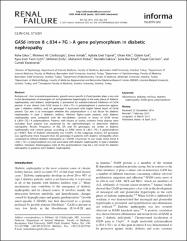GAS6 intron 8 c.834+7G > A gene polymorphism in diabetic nephropathy

Göster/
Erişim
info:eu-repo/semantics/openAccessTarih
2015Yazar
Erkoç, RehaÇıkrıkçıoğlu, Mehmet Ali
Aintab, Emre
Erek-Toprak, Aybala
Kılıç, Ülkan
Gök, Özlem
Yasin Çetin, Ayşe İrem
Zorlu, Mehmet
Kıskaç, Muharrem
Çakırca, Mustafa
Erkal, Sena Nur
İsen, Hayati Can
Karatoprak, Cumali
Üst veri
Tüm öğe kaydını gösterKünye
Erkoç, R., Çıkrıkçıoğlu, M. A., Aintab, E., Erek-Toprak, A., Kılıç, Ü., Gök, Ö. ... Karatoprak, C. (2015). GAS6 intron 8 c.834+7G > A gene polymorphism in diabetic nephropathy. Renal Failure, 37(5), 866-870. https://dx.doi.org/10.3109/0886022X.2015.1034606Özet
Background - Aim: In animal experiments, growth arrest-specific 6 (Gas6) protein plays a key role in the development of mesangial cell and glomerular hypertrophy in the early phase of diabetic nephropathy, and diabetic nephropathy is prevented by warfarin-induced inhibition of GAS6 protein. It was shown that GAS6 intron 8 c.834+7G>A polymorphism is protective against type 2 diabetes mellitus, and AA genotype is associated with higher blood levels of GAS6 protein. Our aim is to investigate whether this polymorphism is a risk factor for diabetic nephropathy in type 2 diabetes mellitus. Method: Eighty-seven patients with diabetic nephropathy were compared with 66 non-diabetic controls in terms of GAS6 intron 8 c.834+7G>A polymorphism. Patients with history of stroke, ischemic heart disease were excluded. Each patient was examined by the ophthalmologist to determine diabetic retinopathy. Results: Frequency of GG, GA and AA genotypes are similar in diabetic nephropathy and control groups according to GAS6 intron 8 c.834+7G>A polymorphism (p = 0.837). Rate of diabetic retinopathy was 54.02%. In the subgroup analysis, GA genotype was significantly more frequent than GG genotype in patients with diabetic retinopathy when compared to without diabetic retinopathy (p = 0.010). Conclusion: In our study, GAS6 intron 8 c.834+7G>A polymorphism was not associated with diabetic nephropathy in type 2 diabetes mellitus. However, heterozygous state of this polymorphism may be a risk factor for diabetic retinopathy in patients with diabetic nephropathy.
WoS Q Kategorisi
Q3Scopus Q Kategorisi
Q2Kaynak
Renal FailureCilt
37Sayı
5Koleksiyonlar
- Makale Koleksiyonu [301]
- Makale Koleksiyonu [3777]
- PubMed İndeksli Yayınlar Koleksiyonu [4230]
- Scopus İndeksli Yayınlar Koleksiyonu [6574]
- WoS İndeksli Yayınlar Koleksiyonu [6631]

















